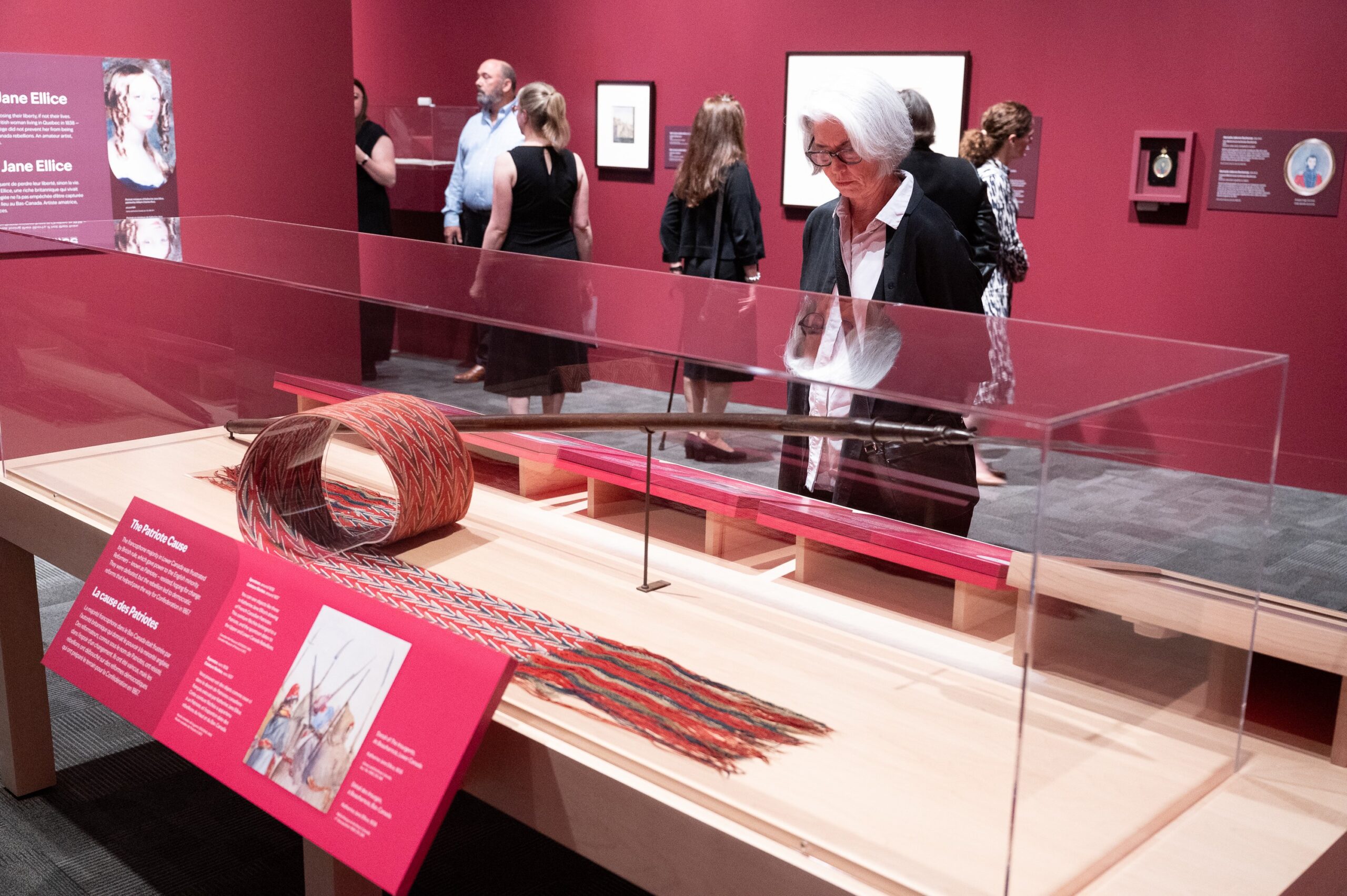Her art. Her battles. Her stories.
The new exhibition “Outside the Lines” at the Canadian War Museum shines a light on two centuries of women’s art about war.
Apt613 spoke with Stacey J. Barker, Ph.D., a historian of arts and military history, to learn more.
The exhibition begins with a juxtaposition of a painting from 2004, and a painting from World War II. Drawing an invisible parallel between the Afghanistan war and the 1940s, the museum invites viewers to consider how the military and war art have evolved over time. And to perhaps ask ourselves: where are we today?
The rest of the exhibition is chronological, beginning in the 1800s and finishing in 2024. Divided into four zones, visitors will take in over 70 diverse works by 52 women artists, including a few from the Ottawa-Gatineau region.
“Each zone has intentional portals—the size of each entrance correlates to the representation of women and women artists during wars,” explains Barker. “In theory, women created art related to conflict in what is now Canada before the 1800s, but it is difficult to find if it has even survived.”
Traveling through “Outside the Lines” is a multi-layered history lesson. It’s delightfully unusual to see the War Museum play the role of an art gallery, bravely taking on the voluminous project of giving a voice to underrepresented women.
The origins of the exhibition
The curators began working on the exhibition in 2020 and it took four years to bring it together. One can imagine the painstaking work of tracking down artists, choosing the pieces and making sure the works speak to each other.

“Because it is thematic, the museum had to decide on a narrative structure to help orient visitors. How women artists in history and women in the military were kept on the margins, parallel to women in society—outside the lines,” adds Barker.
For example, until the Second World War, women were nurses in the war, only then gaining their own service branches. And only in 1989, were they allowed in combat roles. Inevitably, as you travel through the zones, you think to yourself: what would my role be in this time period? What would my life look like? Would I be healing the wounded or assembling weapons? Your feelings may change as you take in the perspectives from each era of Canadian wars.
Zone 1: the 1800s
We begin with a story of an Indigenous woman, Shanawdithit, who drew what she witnessed. Sometimes it is only through a first-person perspective that we can understand someone’s experience.
“The story of conflict on the now-Canadian soil extends to colonization and violence against Indigenous people,” says Barker. It is an ever-poignant reminder to consider your presence on this land. And an invitation to imagine how the first settlements and the continued wars have affected the Indigenous people.

The horrors of war are far-ranging and another woman artist illustrates this point: Katherine Jane Ellice, a Scottish diarist and artist, chronicled her 1838 kidnapping by the Patriotes rebels in Quebec. Her watercolours and diary excerpts of her time as a prisoner are on display.
“Many wealthy British women came to Canada with their husbands and fathers and practiced art as a hobby,” adds Barker. What did the women think about crossing the ocean to a new country? How did they feel about the war? If society wasn’t so patriarchal, would they behave differently? Would there be less war and violence?
The paintings of this zone display defensive structures, landscapes and the first military force sent to confront Louis Riel. The zone feels far away from the present, the artwork carrying the 19th-century fluidity that’s long been converted to realism and a less picturesque, graphic approach to modern art.
Zone 2: 1914–1945
“Zone 2 showcases women as participants, outsiders and witnesses,” explains Barker. It opens with a large painting by Mabel May, displaying women filling shells with toxic chemicals under an unhealthy yellow light, while not wearing protective equipment. Above is an interactive sound dome, inviting visitors to imagine what the factory might have sounded like. A Montreal female musician created the soundscape for the overall exhibition.

During this period, women focused on the war effort at home. Did they want to do this? Was it out of duty & obligation or genuine patriotism and commitment to the cause? And, is equal participation worth the danger?
Throughout the halls, paintings in all mediums are intercepted by sculptures by Elizabeth Wyn Wood, a famous Canadian sculptor. This gives the visitor a break, letting the eye wander on a 3D project before taking in more artwork.
This zone spotlights Molly Lamb Bobak, the only woman appointed an official war artist during the Second World War. She kept illustrations about her journey and even met her husband at war, who was an official artist, too.

Molly Lamb Bobak, Private Roy, Canadian Women’s Army Corps, 1946, Beaverbrook Collection of War Art, CWM 19710261-1626.
Next, we see how Pegi Nicol Macleod depicted a women’s dormitory in the navy—a unique glimpse behind the scenes that would’ve been inaccessible for a male artist. “It is crucial that these two women have been given the opportunity to shed light on the women’s experiences during the war,” says Barker.
Another painting by Macleod shows Ottawa’s War Memorial in 1945, with Chateau Laurier and Parliament in the background. The war artist and activist lived here during her childhood.
Zone 3: Cold War, 1946–1994
Here, the infamous Diefenbunker immediately comes to mind.
Barbara Greene’s “Rainbow in Esquimalt” depicts a submarine designed to detect the Soviet Union’s underwater threats. An anti-war film by Joyce Wieland cleverly uses gerbils (playing rats) and cats to deliver a message against the Vietnam War. The artworks don’t feel so distant anymore—this feels too close for comfort, when you see objects you are familiar with, encountering events from your lifetime. You are confronted with the not-so-distant past, a stark reminder of history repeating itself. You may start to wonder about what the future holds.
“Art is here to get you to think differently,” says Barker. “You don’t have to agree with every artist and perspective.”
In this same zone, Rosemary Kowalsky’s “The Postcard of the Splendid Dead” represents the intergenerational history of war: she served in the Canadian Women’s Army Corps (CWAC). Her father and uncles served in the military, too. How would this vocation affect the entire family? Are the fears, the bravery, the aftermath like PTSD passed down the line?

Daphne Odjig, Anishinaabe (Odawa/Potawatomi) (1919–2016). Genocide, No. 1, 1971. Acrylic on board.
In the same gallery, Daphne Odjig’s apocalyptic-orange painting, influenced by Picasso, depicts the trauma of Indigenous genocide. From the first zone to here, visitors are confronted with Canada’s dark history. The exhibition challenges you to keep multiple perspectives at the front of your mind, so you can understand how differently people experience war, depending on who and where they are.
Zone 4: 1995 to present day
Zone 4 is the contemporary section. Beverley Tosh’s portrait of her mother is from one of her series about war brides, an often missed perspective. How many women married at war? How many travelled to new horizons? How would their lives have unfolded if the wars didn’t happen? Did they seek adventure and escape from the everyday?
“In this section, many artists are looking back on family, giving voice to those who can no longer speak,” explains Barker. You will see many underrepresented and historically oppressed groups spotlighted here, an intentional design to widen your perspective.
“For example, this memorial quilt represents the forgotten segregated battalion of Black Canadians during the First World War, who faced racism while trying to defend the country,” explains Barker. The Government of Canada issued an official apology in just 2022.

Lillian Yano Blakey, Reiko, Alberta, 1945, 2010, Nikkei National Museum & Cultural Centre, 2013.57.1.6.
Across the room, Lilian Yano Blakey documents the Japanese internment camps her mother was forced into. Blakey contrasts this horrific experience of the past with today’s diversity, a hard process to reconcile for the Japanese Canadian artist.
The final spotlight is on Gertrude Kearns, a provocative artist in the Canadian Forces Artists Program. She depicts General Jennie Carignan, the first woman named Canada’s Chief of the Defence Staff and the first woman to command a combat unit.
From then to now, we go from women being accessories to men in the 1800s to women holding leadership roles in the military. From one official female war artist to many.
“There are 52 different perspectives here and more out there. Women have a different approach because historically, they have been outside the lines,” adds Barker. While the museum has done solo shows by women artists before, this is a first of its kind for the national institution.
“Outside the Lines” is on at the Canadian War Museum until January 5, 2025.
This article is sponsored by the Canadian War Museum.












